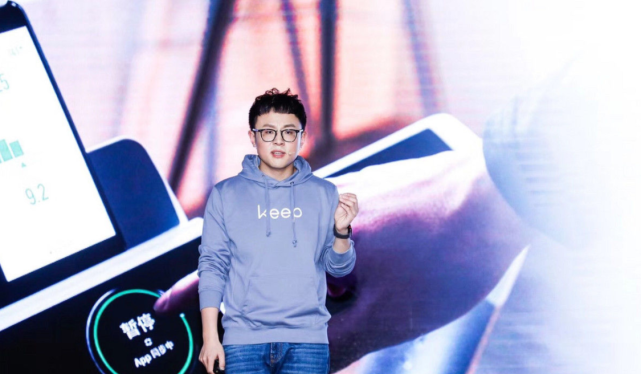In terms of e-commerce business alone, Keep is not inferior to Pelonton, who has been working hard for a long time. But in terms of online services, Keep is in a very embarrassing situation.
After cultivating the industry for seven years and winning eight consecutive rounds of financing, Keep seems determined to embrace the capital market.
According to a report from Sina Technology, Keep is stepping up its plans for an IPO recently, and will apply for a listing in the United States as early as the second quarter of 2021. This is not far from its last financing (January 11 this year, 360 million US dollars) To two months. An insider said that Keep has appointed a CFO and recruited directors of investor relations through multiple channels. He also revealed that Wang Ning, the founder and CEO of Keep, and the management hope that Keep will be listed this year, and that it will be 2022 at the latest.
In response to this news, Keep responded to the media, saying: “We have not received the listing news for the time being.”
In the domestic Internet fitness track, Keep is undoubtedly one of the best. The previous industry pioneers-Gudong, Yuehuan and other recent developments are not as good as before. According to data from Qimai, Keep has long occupied the first place in the iOS “health and fitness” downloads and income list, and it far exceeds other similar apps in terms of data.
On the other hand, as a leading brand in the industry, it is still unknown whether Keep can create a stable and effective way of realizing business. This is the point that investors are most worried about. At the same time, the product lacks a strong moat, and it is difficult to maintain continuous user growth. Keep will face a big problem in the future. Before they are completely resolved, Keep’s road to market will probably be covered forever.
The Internet fitness market is full of strong players. Why keep is the bigger one?
Before the creation of Keep, Wang Ning’s life was almost like going to a market-jumping from a university classroom to a company, and then from this company to that company, and his internships were all in the same direction as the popular mobile Internet at the time. Industry related.
“I was very anxious at the time and felt that I could not catch up with this wave. So as long as it was an internship opportunity, I would accept it, so I could do anything.You just need to let me in and let me work. I do all of manpower, finance, administration, operations, products, and testing. “In an interview, Wang Ning described his life before starting a business.
After graduating from university, Wang Ning discovered a new entrepreneurial opportunity from a successful weight loss. At that time, he used the information collected on the Internet to lose weight from 180 kg to 130 kg in only half a year, and became a neighboring friend. Who are competing for advice. When sharing information, Wang Ning discovered that many of his friends had not formulated a systematic weight-loss training program, so even if the information was given, it would be at a loss. This experience gave him the idea of making a mobile fitness application.
Just do it if you think about it. This is Wang Ning’s consistent style. When he was in college, he couldn’t bear the tedious process of refreshing the timetable, so he quickly made an App to solve the problem. He didn’t think much when he created a new product this time. In the summer of 2014, Wang Ning started the journey of code farmers with Zehou Capital’s 3 million yuan investment, a few classmates and former colleagues, and a product prototype. Three months later, Keep was born and officially launched in February 2015. At that time, Wang Ning’s vision for it was that 100% of people can exercise like 10% of fitness experts.
Wang Ning is not the first person to see opportunities in the fitness market through the concept of mobile Internet. Before Keep was officially launched, sports apps such as Gudong and Yuehuan were already popular among the younger generation who are keen on fitness. Among them, the number of users of Gudong Sports exceeded one million in 2013, and it became a popular target of capital at that time after combining with Baidu’s hardware direction such as bracelets. Compared with these experienced predecessors, Keep’s future looks a bit slim.
But the actual situation is that just a few months after Keep went online, it has grown users to the order of one million, and at the same time, it has also won US$5 million in Series A financing from Intime Capital and Bestman Asia Investment. As of July 2018, Keep has completed five consecutive rounds of financing, and the total number of users has exceeded 140 million, leaving its once out-of-reach opponents far behind.
Deep into the reasons for the rise of Keep. In addition to targeting the sports novices to exert their power, the social element also contributes-Keep has built a sports-themed discussion square where users can freely output their opinions. In addition, through rankings, challenges, sports stickers, records, etc., Keep has successfully associated active users on the platform with new users, which undoubtedly greatly improves user stickiness and makes Keep out of the traditional tool application category. Begin to shift towards community-based applications.
After getting the investor’s money, what kind of commercialization story does Keep want to tell?
Since his founding, Wang Ning has always followed Ming Taizu’s popular motto-“Build walls, accumulate grain, and slowly become king”, and has been quite cautious in brand commercialization. In 2016, Keep tried to sell sports peripheral products on the online shopping mall. However, due to the low repurchase rate of the main category of sports goods, the Keep e-commerce department failed to make beautiful results for a long time, but Wang Ning seems I didn’t even think about cutting down the business and opening up a new path.
For the next two years, Keep has maintained an unhurried pace until 2018—In March of that year, Wang Ning held the company’s first strategy and new product launch conference since its establishment. At the meeting, he said that the future Keep will create a “new technology-connected sports ecology”. This ecology will use Keep App as its origin and expand its business for both urban and home scenarios, including urban sports space Keepland and home smart hardware KeepKit.
Just after this strategic conference was held, Keep’s first Keepland opened at the China Central Place in Beijing. In July of that year, Keep received another US$127 million in financing from institutions such as Tencent Investment, Goldman Sachs, and Jiyuan Capital. The huge blessing from capital, especially from the giant Tencent, gave Wang Ning the confidence to further attempt commercialization.
In 2019, Keep launched smart hardware treadmills, sports bracelets, and walking machines. Keep’s expectation of smart hardware is to use its built-in modules to obtain users’ daily training data, thereby reminding users to adjust their training rhythm and training in real time. speed. In the same year, Keep kept up with the popular light food trend and launched a new brand KeepLite in an attempt to seize the market.
Frequently increasing the number of new businesses can make Keep’s story richer, but it also makes the company’s structure extremely complex. This situation prompted Keep to carry out a large number of personnel and business optimizations at the end of 2019-implementation At the employee level, it is layoffs. According to public information, this round of layoffs involves 10%-15% of Keep’s total employees. At the same time, a Keepland store on Qingnian Road in Beijing was also closed. In May 2020, Keepland closed three more stores in the Shanghai area.
On the other hand, capital does not seem to be very optimistic about Keep. Starting in July 2018, Keep’s financing round has been suspended for 22 consecutive months. It was not until May 2020 that Keep completed a new round of 80 million. U.S. dollar financing.
After this, Keep’s overall situation seems to start to improve. At the media communication meeting on June 4, 2020, Liu Dongfang, Vice President of KeepThere is a big news-the company has achieved overall profitability. Since then, Keep has also released news about the company’s smooth commercialization progress in various major channels. In August last year, Liu Dong explained in detail Keep’s commercialization model to the media.
“Now our commercialization direction is very clear, one is sports consumer goods GMV, the other is online services. But our ultimate goal is to generate some value-added services on sports solutions.” Liu Dong said.
Keep, with a total of over 100 million users, can’t attract users’ interest?
Although Wang Ning often regards Nike as Keep’s future goal, the capital market is more willing to compare it with Pelonton (PTON.O), a US stock-listed company that also focuses on smart fitness. After all, these two companies have many places. Similarities.
From the perspective of Pelonton’s financial report, 80% of its revenue comes from sales of fitness-related products, and only 20% comes from platform subscription content. This coincides with Keep-according to data released by Keep Vice President Liu Dong, Keep’s consumer goods GMV in 2020 has reached a scale of 1 billion yuan, and the offline consumer goods business has also achieved nearly 300% of revenue in 2019. Increase. Liu Dong believes that the two revenues of consumer goods and online services can completely offset all the costs of Keep.
At present, in addition to traditional sports peripheral products such as women’s clothing, men’s clothing, indoor fitness, outdoor running, yoga meditation, and sports protective gear, Keep Mall also adds new categories such as sports bracelets, health food, and home intelligence. On this point alone, Keep is not inferior to Pelonton, who has been working hard for a long time.
However, in terms of online services mentioned by Liu Dong earlier, Keep’s situation is very embarrassing.
On the one hand, in order to meet the commercialization needs of brands and reduce operating costs, Keep has begun to increase the price of paid content on the platform in recent years, and has also added a variety of third-party self-made content to the free content; but on the other hand, On the one hand, most of Keep’s users have not been able to develop a fixed payment habit, after all, they are all used to Keep’s free policy in the early years. This situation makes it difficult for Keep to maintain its previous high-speed growth of users.
In order to increase the frequency of users’ use, Keep opened an online live broadcast service connected with smart hardware through the outbreak of the epidemic last year, and jointly launched a “full network sports live broadcast schedule” with a number of sports organizations.



